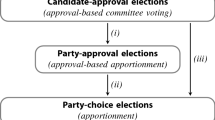Abstract
Condorcet’s Jury Theorem (CJT) provides a theoretical basis of public choice theory and political science. This paper provides an extension of CJT for random subcommittees consisting of dependent heterogeneous experts. Necessary and sufficient conditions for beneficial augmentation (reduction) of the size of a random subcommittee are provided. These results are applied in several dependency models.
Similar content being viewed by others
References
Austen-Smith D, Banks JS (1996) Information aggregation, rationality and the Condorcet Jury theorem. Am Polit Sci Rev 90(1):35–45
Ben-Yashar R, Paroush J (2000) A non-asymptotic Condorcet Jury theorem. Soc Choice Welf 17:189–199
Berend D, Paroush J (1998) When is Condorcet’s Jury theorem valid? Soc Choice Welf 15:481–488
Berend D, Sapir L (2005) Monotonicity in Condorcet Jury theorem. Soc Choice Welf 24:83–92
Berg S (1993) Condorcet’s Jury theorem revisited. Eur J Polit Econ 9:437–446
Berg S (1997) Indirect voting systems: Banzhaf numbers, majority functions and collective competence. Eur J Polit Econ 13:557–573
Berg S, Paroush J (1998) Collective decision making in hierarchies. Math Soc Sci 35:233–244
Boland PJ (1989) Majority systems and the Condorcet Jury theorem. Statistician 38:181–189
de Condorcet NC (1785) Essai sur l’application de l’analyse à la probabilité des décisions rendues à la pluralité des voix. Paris (see McLean I, Hewitt F, translators, 1994)
Dietrich F, List C (2004) A model of jury decisions where all jurors have the same evidence. Synthese 142:175–202
Feddersen T, Pesendorfer W (1998) Convicting the innocent: the inferiority of unanimous jury verdicts under strategic voting. Am Polit Sci Rev 92:23–36
Feld S, Grofman B (1984) The accuracy of group majority decisions in groups with added members. Public Choice 42(3):273–285
Grofman B, Owen G, Feld S (1983) Thirteen theorems in search of the truth. Theory Decis 15:261–278
Kanazawa S (1998) A brief note on a future refinement of the Condorcet Jury theorem for heterogeneous groups. Math Soc Sci 35:69–73
Karotkin D, Paroush J (2003) Optimum committee size: quality-versus-quantity dilemma. Soc Choice Welf 20:429–441
Ladha KK (1992) The Condorcet Jury theorem, free speech, and correlated votes. Am J Polit Sci 36(3):617–634
Ladha KK (1993) Condorcet’s Jury theorem in light of de Finetti’s theorem. Soc Choice Welf 10:69–85
Ladha KK (1995) Information pooling through majority-rule voting: Condorcet’s Jury theorem with correlated votes. J Econ Behav Organ 26:353–372
Maranon A (2000) The uncertain dichotomous choice model: some results. PhD dissertation, Lund University, Sweden
Miller N (1986) Information, electorates, and democracy: some extensions and interpretations of Condorcet Jury Theorem. In: Grofman B, Owen G (eds) Information pooling and group decision making. JAI Press, Greenwich
Nitzan S, Paroush J (1984) The significance of independent decisions in uncertain dichotomous choice situations. Theory Decis 17(1):47–60
Nitzan S, Paroush J (1985) Collective decision making. Cambridge University Press, Cambridge
Paroush J (1998) Stay away from fair coins: a correct Condorcet’s Jury theorem. Soc Choice Welf 15:15–20
Paroush J, Karotkin D (1989) Robustness of optimal majority rules over teams with changing size. Soc Choice Welf 6:127–138
Sapir L (2005) Generalized means of juror’s competences and marginal changes of jury’s size. Math Soc Sci 50:83–101
Young H (1989) Condorcet’s theory of voting. Am Polit Sci Rev 82:1231–1244
Author information
Authors and Affiliations
Corresponding author
Rights and permissions
About this article
Cite this article
Berend, D., Sapir, L. Monotonicity in Condorcet’s Jury Theorem with dependent voters. Soc Choice Welfare 28, 507–528 (2007). https://doi.org/10.1007/s00355-006-0179-y
Received:
Accepted:
Published:
Issue Date:
DOI: https://doi.org/10.1007/s00355-006-0179-y




